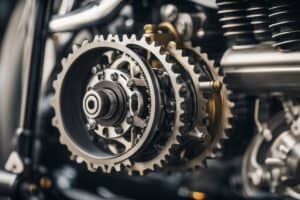Discovering a vacuum leak in your motorcycle can be a real headache, but don’t worry, you’re not alone.
This common issue can cause all sorts of performance problems, from erratic idling to a significant loss of power.
Fortunately, with the right approach, you can tackle it head-on.
Addressing a vacuum leak requires a keen eye and a methodical approach.
It’s about knowing where to look and what to do when you find it.
In this guide, you’ll learn how to identify the signs of a vacuum leak and the steps to fix it, ensuring your ride is smooth and your engine runs as it should.
Signs of an Engine Vacuum Leak
Detecting a vacuum leak in your motorcycle’s engine can be straightforward if you know what symptoms to look for.
Starting with uneven idle, it’s a clear indicator something’s amiss.
Your bike might rev erratically or experience a pronounced dip in RPMs.
This can occur because the leak introduces extra, unmetered air into your engine, disrupting the air-fuel balance.
Another tell-tale sign is poor performance and acceleration.
If your motorcycle hesitates when you twist the throttle or feels sluggish, a vacuum leak could be to blame.
The vacuum system in your motorcycle is critical for delivering precise fuel quantities to the engine; any deviation due to a leak can hamper its ability to accelerate properly.
Unexpected engine stalls also point towards potential vacuum leaks.
While riding, if your motorcycle stalls out without an obvious reason, the vacuum integrity may be compromised.
The motorcycle’s inability to maintain the required air-to-fuel ratio can cause intermittent stalls and may require immediate attention.
Lastly, listen for hissing sounds coming from the engine area.
A vacuum leak can sometimes produce a noticeable hiss or whistle, which is the sound of air escaping from a breach in the vacuum system.
Pinpointing the noise will often lead you directly to the source of the leak.
Your keen observation and quick response to these signs can prevent further issues and ensure you handle vacuum leaks effectively.
Tools and Equipment Needed

Before diving into addressing your motorcycle’s engine vacuum leak, make sure you’ve got all the necessary tools and equipment on hand.
Adequate preparation is key to a smooth repair process.
You’ll need the following items:
- Vacuum Hose: Check if you’ve got spare vacuum hoses available.
They’re essential if you need to replace cracked or worn hoses.
- Carburetor Cleaner: This will help you spot leaks quickly by causing the engine’s idle speed to change when sprayed near a potential leak.
- Screwdrivers: A set of screwdrivers is necessary for removing parts that may be blocking access to vacuum lines.
To help you with specific fixes:
- Pliers: Sometimes you’ll need these to remove clamps or pull out hoses without causing damage.
- Socket Set: It’s crucial to have a variety of sockets to loosen and tighten different bolts.
- Thread Sealant: Use this on the fittings to ensure an airtight seal after performing any repairs.
Collect these tools beforehand to avoid any interruptions once you begin repairs.
Properly equipping yourself is a proactive step in maintaining the pristine condition of your motorcycle.
Locating the Vacuum Leak

After you’ve gathered your tools for addressing a motorcycle’s engine vacuum leak, the next critical step is locating the source of the leak.
Idle behavior can be a strong indicator.
A motorcycle engine with a vacuum leak may idle at higher RPMs than normal or fluctuate erratically.
Listen carefully; an engine struggling to maintain consistent idle speed is calling for your attention.
To pinpoint the leak, start with a visual inspection.
Look for obvious signs of wear or damage to vacuum hoses and connections.
Oftentimes, a worn-out hose is visibly cracked or brittle.
If the visual inspection doesn’t reveal any clues, move on to the carburetor cleaner method.
With your engine running, spray a small amount of carburetor cleaner at each connection point of the vacuum system.
When the RPMs change as you spray, you’ve found the culprit.
The cleaner temporarily seals the leak, affecting the engine’s idle speed.
If this method isn’t conclusive, employ the smoke test as a last resort.
Introduce smoke into the vacuum system and watch for where the smoke escapes – that’s where your vacuum leak lurks.
Remember to perform the smoke test in a well-ventilated area and keep all ignition sources away to prevent any accidents.
Common Causes of Vacuum Leaks

When dealing with engine vacuum leaks in motorcycles, understanding the common causes is vital.
Age and wear naturally degrade motorcycle components.
Over time, the rubber hoses and gaskets that maintain a tight seal can become brittle and crack, leading to leaks.
Improper installation of components can also create vacuum leaks.
After doing maintenance or upgrades, if you don’t secure hoses and connections properly, air might seep through the gaps.
It’s essential to follow manufacturer guidelines and torque specifications to ensure everything is snug and seated correctly.
Environmental factors can’t be overlooked.
Extreme temperatures and exposure to harsh chemicals or oils can compromise the integrity of vacuum lines.
- Aging and degradation of materials
- Loose or incorrect installation of parts
- Harsh environmental conditions
Regular inspections can help you spot early signs of wear and avoid the compounding problems that vacuum leaks can cause.
If you notice your motorcycle has started to idle erratically or you hear hissing noises, it’s time to check for these common issues.
Fixing the Vacuum Leak

Once you’ve identified a vacuum leak, you’ll need to address it promptly to prevent further damage to your motorcycle’s engine.
Replacement of damaged parts is usually the most reliable fix.
Begin by assessing the condition of all vacuum hoses and gaskets.
If you find cracks or signs of wear, it’s time to replace them.
You should always use parts that meet or surpass the manufacturer’s specifications.
Installation is critical, so follow the service manual carefully or seek professional assistance.
When replacing gaskets:
- Drain any fluids that might interfere with the process.
- Remove the old gasket and clean the mating surfaces thoroughly.
- Place the new gasket without any twisting or overstretching.
While working on hoses:
- Measure and cut the new hose to the correct length.
- Attach it securely to ensure there are no gaps or loose ends.
- Double-check all connections and clamps for a snug fit.
After the replacements, test your motorcycle to ensure the leak has been effectively fixed.
Start your engine and listen for the previous signs of a vacuum leak.
You might also want to use a vacuum gauge to check for proper vacuum pressure.
Regular maintenance post-fix can prevent future leaks, so don’t skimp on subsequent inspections.
Frequently Asked Questions
What is a vacuum leak in a motorcycle?
A vacuum leak in a motorcycle refers to a breach in the engine’s intake system which allows excess air to enter, disrupting the air-fuel mixture and causing engine performance issues.
How can I identify if my motorcycle has a vacuum leak?
Signs of a vacuum leak include unstable idling, difficulty starting, and a noticeable drop in engine performance.
You might also hear a hissing sound indicating air is escaping from somewhere it shouldn’t.
What are some common causes of vacuum leaks in motorcycles?
Vacuum leaks primarily stem from worn or damaged intake manifolds, cracked hoses, or degraded gaskets.
These faults may occur due to regular wear and tear or improper maintenance.
How do I fix a vacuum leak in my motorcycle?
Fixing a vacuum leak usually involves replacing the damaged hoses, gaskets, or parts in the intake system.
Ensure all replacements meet manufacturer specifications and that they’re installed correctly to avoid future issues.
Should I use OEM parts for repairs to fix a vacuum leak?
It’s advised to use OEM (Original Equipment Manufacturer) parts or those that meet or exceed the OEM specifications to ensure the best fit and function.
How do I test my motorcycle after repairing a vacuum leak?
After repairs, thoroughly test your motorcycle by running the engine at various speeds and checking for consistent idling and performance.
Listen for any unusual sounds that could indicate an unresolved leak.
Is regular maintenance helpful in preventing vacuum leaks?
Yes, regular inspections and maintenance can help identify potential issues early and prevent vacuum leaks from developing or worsening over time.
As an Amazon Associate we earn from qualifying purchases.










